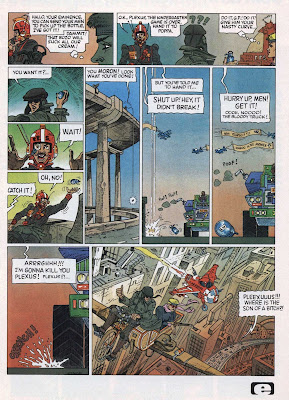Showcase Presents: 'The Warlord'
by Mike Grell
After looking on in envy all during the early 70s as Marvel enjoyed strong sales from its 'Conan' franchise and its numerous spinoffs, DC Comics' management decided to make a trial run into the sword-and-sorcery genre by printing Mike Grell's 'Warlord' comic in the November, 1975 issue of 1st Issue Special.
Reader response to the comic was favorable, and DC went ahead and made 'The Warlord' its own title, allowing Grell - a talented veteran of the comic book industry - to provide both art and story, which back in those days was a rare step on the part of the management at the large comic book companies.
The first issue of 'The Warlord' was issued in early 1976, and the comic quickly became one of DC's strongest sellers, ultimately lasting for an impressive (for a non-superhero title) 133 issues through September 1989.
This 'Essentials' volume reprints - in black and white - the content from 1st Issue Special and 'The Warlord' issues 1 - 28 (January - February 1976 to December 1979).
The premise of the story incorporates a number of familiar sf and fantasy themes: US Air Force pilot Travis Morgan loses control of his SR-71 'Blackbird' spy plane over the North Pole, and passes into a Hollow Earth world (called Skartaris) marked by eternal sunlight, a tropical ecosystem populated by barbarian tribes and dinosaurs, and, of course, nubile women wearing scanty furs from the Vampirella and Red Sonja schools of heroine fashion.
After only a few weeks in Skartaris, Morgan abandons his military-regulation haircut, grows a beard, dons a loincloth, learns how to wield a sword, and takes to his new home with enthusiasm..... and dry humor.
The majority of the issues released during The Warlord's first three years were single-episode in nature, as opposed to relying on longer, multi-issue story arcs. When combined with the fact that The Warlord was a Code book, this meant that the plots tended to be oriented towards a straightforward adventure narrative, one reliant on depictions of overt action and drama.
However bounded he was by editorial policies in terms of his scripts, Grell was a skilled artist when it came to rendering scenes of dynamic, sword-and-shield combat.
The latter issues in this compilation indicate that, with the title's financial success, Grell was given greater leeway in terms of content; as well, the advent of frequent barbarian / sword and sorcery stories in 'adult' comics like Heavy Metal and the Warren magazines, in the late 70s, seems to have further loosened the editorial restrictions imposed on The Warlord.
While remaining distinctive in its own right, Grell's artwork began to take on a more ornate, 'artistic' visual style, one similar to that used by South American, European, and Philippino artists like Alex Nino, Esteban Maroto, and Gonzalo Mayo for their fantasy comics in Eerie and Creepy.
Summing up, if you are a fan of 70s sword-and-sorcery comics, then Showcase Presents: The Warlord is worth getting. However conventional his plots may have been during the book's first three years, Grell's artwork always was of high standards and, in my opinion, superior to some of the artwork appearing in the modern-day sword-and-sorcery comics.




































































.jpg)
















